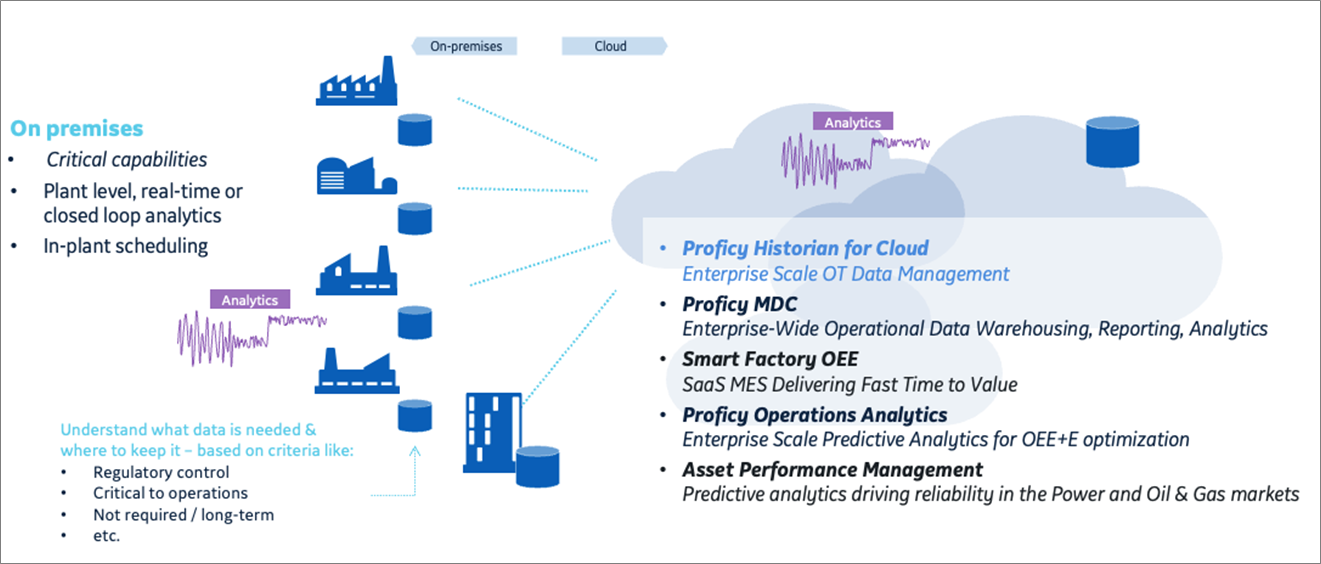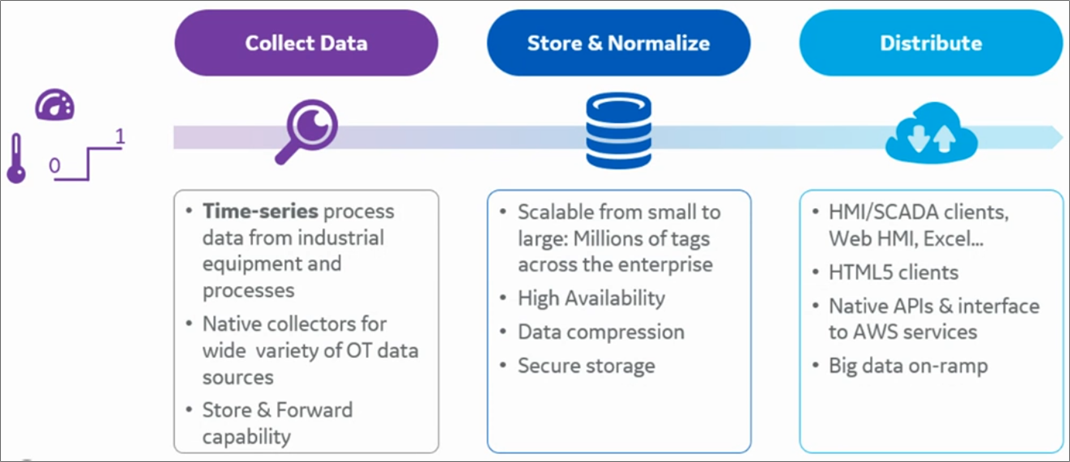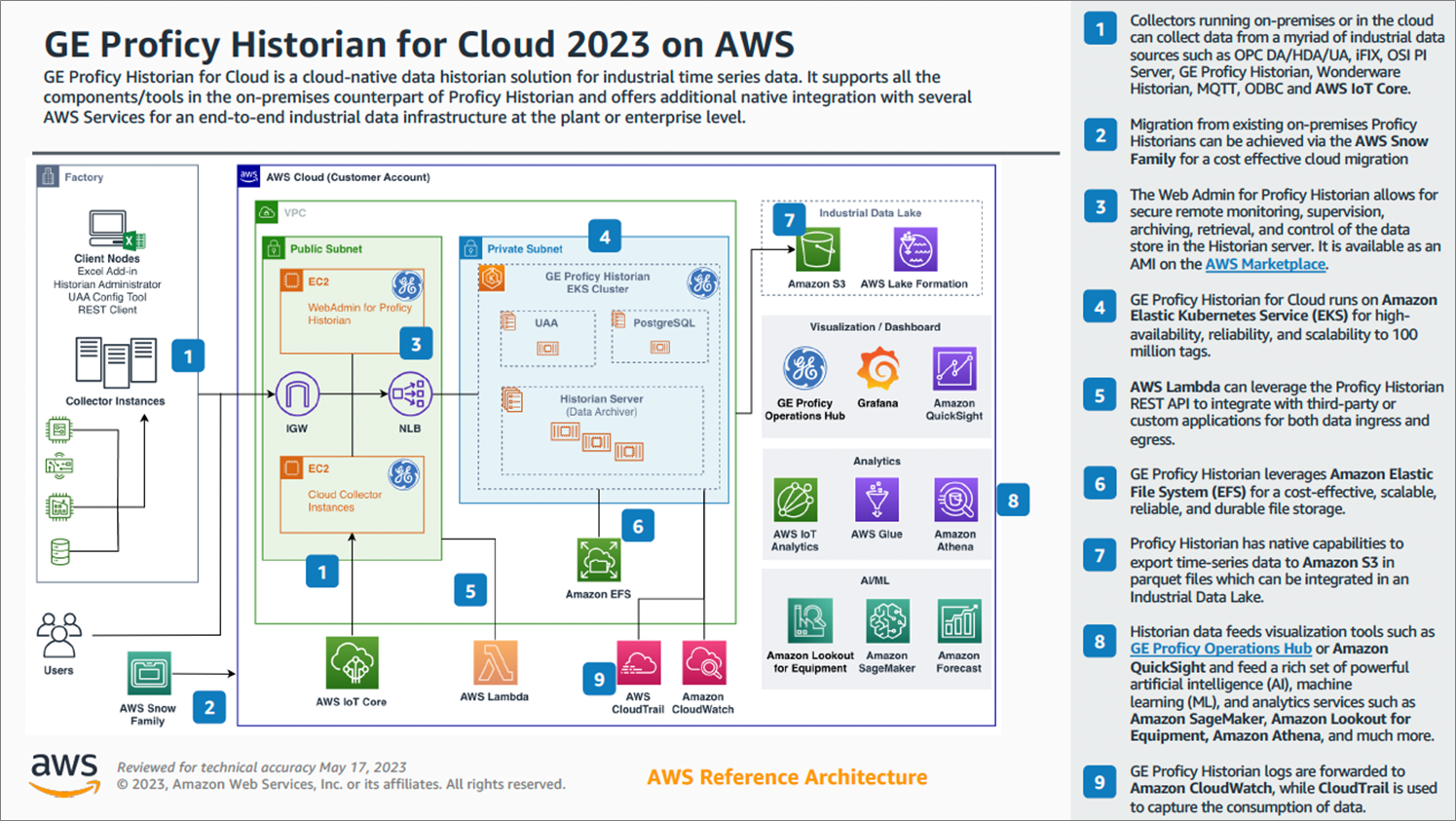AWS Partner Network (APN) Blog
Accelerate Operations Technology Data Insights with GE’s Cloud-Native Proficy Historian
By Steve Pavloski, VP, Product Management – GE Digital Manufacturing
By Dario Rivera, Sr. Solutions Architect – AWS
By Gabriel Verreault, Sr. Solutions Architect – AWS
 |
| General Electric |
 |
Cloud is playing a growing role in operations technology (OT) data management, which has traditionally been on-premises. What’s been missing is the ability to move OT data to the cloud at scale at an affordable cost.
Without the ability to consolidate transactional data with OT/process data, insights are limited. The potential for enterprise-wide operations optimization has remained unrealized because the technology that combines the capabilities of an operational historian with cloud-native deployment hasn’t existed until now.
Working with Amazon Web Services (AWS) and building on its position as an industrial software leader, GE Digital introduced Proficy Historian to help industrial organizations to quickly and cost effectively get their OT data in the cloud.
In this post, we will explore how this new cloud-based historian from GE helps organizations accelerate their ability to gain insights from OT data by securely and efficiently moving it to the cloud. We’ll provide background on GE’s 35+ years of experience in industrial software, explain what a historian is and why it’s important, and outline the challenges traditional historians have faced in the cloud.
We will also introduce Proficy Historian on AWS, highlighting its cloud-native architecture, use cases, integration with other AWS services, and availability in AWS Marketplace for easy deployment. Readers will come away with a grasp of how this cloud-native historian can help industrial companies transform their operations by unlocking greater value from OT data in the cloud.
General Electric (GE) is an AWS Manufacturing and Industrial Software Competency Partner that provides a portfolio of AWS-based applications across industries including manufacturing, power generation, oil and gas, and healthcare.
35+ Years of Industrial Software Innovation
GE has been an industrial software leader for more than 35 years, with its flagship Proficy portfolio products in human machine interface/supervisory control and data acquisition (HMI/SCADA), manufacturing execution systems (MES), and industrial data management. Thousands of diverse organizations around the world use GE’s industrial software.
In the industrial environment, GE’s software connects people, processes and equipment–monitoring, controlling, and optimizing. The software gathers data from industrial plants and creates business insights that support metrics-based decision-making. The software aggregates, contextualizes, and visualizes the data to help mobile operators and supervisors gain awareness from the machine, line, plant, and enterprise.
Combined with AWS innovation, the data is combined from multiple plants and aggregated in the cloud to support enterprise-scale applications, analytics, and optimization, helping to drive consistency across plants and improve quality and efficiency.
Through its collaboration with AWS, GE Digital is taking its industrial software solutions portfolio and moving applications to the AWS cloud as AWS Marketplace solutions, including Proficy Historian for cloud.
GE and AWS Change OT Data Management
As industrial companies look at solutions to bridge OT data with information technology (IT) systems and analytics in the cloud, it’s challenging to do so in a cost-effective manner while maintaining the functionality of on-premises data historians for high volume of real-time data streams.
Rather than rely solely on opening insecure ports or developing complex custom integrations, industrial customers look to have seamless connectivity between operations data and cloud-based storage, computing, and analytics.
With Proficy Historian for Cloud and AWS, cloud-based OT data management–at scale and affordable–is a reality to have a purpose-built option to move historian data to the cloud securely and efficiently.
Figure 1 – GE Digital and AWS cloud journey.
What is a Historian?
Operational historian software collects real-time operational data from diverse industrial applications and devices, including databases, control systems, programmable logic controllers (PLCs), and building management systems. The historian software then aggregates and compresses data into a highly available centralized repository with guaranteed no data loss and store-and-forward capability.
The historical data is available for monitoring asset performance, visualizing trends, creating reports, and performing analytics. For the last three decades, data historians have played a critical role in enabling companies to leverage their operational data at scale to drive insights.
Figure 2 – Historian data lifecycle used to erive manufacturing insights.
Cloud-Native OT Historian
GE Digital introduced within Proficy Historian the capability to move telemetry data stored in the on-premises software version to AWS via the AWS IoT Core managed cloud service. Many operational historians have been moving data to the cloud for a few years. However, native cloud-based historians with owner-access to their data have traditionally eluded the industrial market until now.
One of the common challenges of asset management in the industrial space is managing a wide variety of data producers with differing messaging protocols. Traditional historians, including Proficy Historian, were not designed to utilize cloud infrastructure. Industrial domain original equipment manufacturer (OEM) providers understood that running Historian software on an infrastructure as a service (IaaS) platform was cost-prohibitive given existing Historian software architectures.
Historian software architectures don’t often offer the capability to move collected plant data out of its proprietary storage systems to cloud-based big data services. These big data services are the foundation for data-innovation architectures such as data lakes and lake house. These architectures are the conduit for business innovation possibilities that are key to the manufacturing industry’s digital transformation goals.
Cloud-hosted Historian solutions in the market come with challenges for industrial users, including:
- Complex connectivity options to existing on-premises environments and regulatory restrictions to send sensitive process data to third-party providers.
- Lack of easy integration with cloud-native and third-party tools and services via an open API.
- Limited integration and migration patterns with existing legacy historian deployments.
Traditional industrial use cases supported by cloud-based time-series managed services also have challenges, such as:
- Cost-prohibitive to store high-frequency data at scale (tens of thousands of events per second).
- Not meeting the performance requirement needed by the industrial use case.
- Integrating with existing suite of purpose-built visualization and analytical applications is too complex.
GE Digital set out to build a cloud-native hosted historian service that would:
- Leverage cloud technology for automated deployment, data replication, reduced environmental footprint, scalability, and zero downtime upgrades.
- Maintain interoperability with existing on-premises applications.
- Simplify moving OT data to the cloud for artificial intelligence (AI) and analytics at scale.
- Grant user full control over the network access by running in a secure isolated virtual private cloud (VPC) in the customer AWS account.
Proficy Historian on AWS
Proficy Historian on AWS can efficiently and securely store tens of millions of records per minute on AWS.
Proficy Historian enables the existing application on the factory floor to access it with no integration work required, leveraging the same APIs. Proficy Historian provides native export to Amazon Simple Storage Service (Amazon S3) to immediately take advantage of data lakes and the whole portfolio of other AWS services. These services include AI and other analytical services that offer insights into operational data that were difficult to accomplish historically.
GE’s cloud-native Proficy Historian offers a bridge between on-premises manufacturing applications and AWS, bringing a unique combination of capabilities to the market. Manufacturers can immediately ingest into the AWS cloud from various data sources such as Internet of Things (IoT) sensor data from multiple protocols, DCS/SCADA systems, ODBC-based data from relational databases, and everything in between.
Proficy Historian offers this connectivity with store-and-forward capabilities and at-rest/in-transit encryption. These capabilities allow operational historian users to leverage that operational data for second and third-tier analytics workloads.
Historian in the Cloud Use Cases
As part of hosting their historian software, industrial plant operators want to move away from labor-intensive, non-differentiating activities such as operations and maintenance of on-premises IT servers. Using a cloud-native historian solution allows plant operators to lower operations costs while accessing real-time data quickly. They can also migrate their historical local sensor/telemetry data to the cloud at consumption-based pricing.
Manufacturing plants are organized within a hierarchy at the enterprise level, with several data sources per plant, each with unique data governance requirements.
Often, there’s a need to aggregate the data created across that enterprise hierarchy. A cloud-based historian solution with an open API that offers export/import access to downstream historian data provides simple access to the aggregation, visual analytics, and AI capabilities. These capabilities allow third-party point solutions software and big data solutions engineers to offer valuable business insights to the enterprise stakeholders.
Lastly, many historian-using organizations have access to various data sources that stakeholders can use to supplement their historian data. Aggregating these multi-modal data sources within a limitlessly-scalable data lake in the cloud offers solutions for business insights. Attempting to support the same data aggregation and manipulation level with on-premises resources would be challenging and cost-prohibitive.
Immediate Value from AWS Marketplace
Proficy Historian is currently available in AWS Marketplace. Using GE Proficy Historian as an AWS Marketplace solution supports offers immediate benefits such as:
- Consumption-based pricing is billed as an extension of your existing AWS costs.
- Automated deployment directly into your customer-owned cloud account.
To launch Proficy Historian in your AWS account, answer a few questions on the product’s AWS Marketplace landing page. In under an hour, a fully operational industrial data historian is securely deployed in your environment, isolated in a secure VPC, and ready to ingest industrial data from pre-built data collectors that can be deployed near their data source, on-premises, or in the cloud. These collectors offer easy on-premises data source connectivity configuration, and support hundreds of protocols, including OPC-UA, OPC-DA, and MQTT for IoT workloads.
There are also native interface connections to third-party historians like Aveva PI Server (previously OSIsoft PI), and interfaces with ODBC data sources to support relational databases. There’s also support for protocol converters that can take any industrial protocol and convert it to OPC-UA. Once those converters are installed and configured, data can start streaming from on-premises data sources into the cloud and is ready to be integrated with visualization and analytical tools.
AWS Well-Architected
GE Proficy was built on AWS to take advantage of the AWS Well-Architected tenants. The cloud-native Proficy Historian:
- Securely runs in a VPC within a customer-owned cloud account.
- Leverage Kubernetes across multiple AWS Availability Zones (AZs) for high-availability and scalability.
- Amazon Elastic File Service (Amazon EFS) is the storage layer of Proficy Historian. Amazon EFS is a highly performant managed service that automatically grows and shrinks as you add and remove data with no need for provisioning and managing infrastructure.
- Automated scheduled export of tag data to Amazon S3 via Parquet files to support data lake architectures, allowing data access to AWS’s analytics and AI services and use cases.
GE’s cloud-native Proficy Historian also supports third-party integrations such as Seeq analytic software. Given Proficy Historian’s on-premises legacy integration with Seeq, the SaaS offering from Seeq directly integrates with Proficy Historian’s cloud-native version.
Utilizing these features allows global enterprises to achieve better performance while only paying for what they need. Historian deployments via AWS Marketplace are automated, repeatable, and available in multiple geographies, letting historian users go global in minutes.
Figure 3 – GE Proficy Historian cloud architecture.
Conclusion
The Proficy portfolio offers data migration tools to take years of legacy historian data and migrate it to AWS. Whether deployed in a single plant or an entire enterprise, organizations can leverage the power of Proficy Historian’s scalability combined with AWS.
GE Digital’s cloud-native Proficy Historian offers immediate value in overcoming traditional blockers of obtaining value from the historical and real-time telemetry data managed by on-premises historians today.
A cloud-native historian allows migrating on-premises historian-managed data to a secure-by-design, scalable, and performant data lake. Bringing that data to the cloud and closer to AWS services offers many opportunities to provide direct business value through enterprise-wide optimization.
You can learn more about Proficy Historian in AWS Marketplace.
General Electric – AWS Partner Spotlight
General Electric (GE) is an AWS Partner that provides a portfolio of AWS-based applications across industries including manufacturing, power generation, oil and gas, and healthcare.
Contact Partner | Partner Overview | AWS Marketplace | Case Studies



